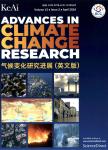Economic development, energy demand, and carbon emission prospects ofChina's provinces during the 14th Five-Year Plan period: Application ofCMRCGE model
经济开发,精力需求,和碳排放在第 14 五年的计划时期期间瓷器勘探省: CMRCGE 的申请模型作者机构:State Information CenterBeijing100045China Institute o f EnergyEnvironment and EconomyTsinghua UniversityBeijing100084China State Grid Energy Research Institute Co”Ltd”Beijing102209China Tianjin Science and Technology UniversityTianjin300222China
出 版 物:《Advances in Climate Change Research》 (气候变化研究进展(英文版))
年 卷 期:2019年第10卷第3期
页 面:165-173页
核心收录:
学科分类:0202[经济学-应用经济学] 02[经济学] 020205[经济学-产业经济学]
基 金:s This work was supported by the National Key Technology Research and Development Program of the Ministry of Science and Technology (2016YFA0602601) Science and Technology Project of the State Grid Corporation of China Headquarters ''Research and Development of China Multi-regional Compre hensive Analysis and Forecast Mcxlel System for Energy Sup ply and Demand Fourth National Climate Assessment Report: Mitigation of Climate Change’’ and National Natural Science Foundation of China Program (71573145 71573062)
主 题:Coordinated development CMRCGE model 14th Five-Year Plan Energy demand Carbon emissions
摘 要:This study focuses on a national regional coordinated development strategy and adopts China Multi-Regional Computable General Equilibrium model to analyze the economic and social development, energy demand, and carbon emissions of the provinces during the 14th Five-Year Plan (FYP, 2021 2025) period based on the economic development and energy demand since the New Normal. The main conclusions are the following: 1) Under the guidance of the regional coordinated development strategy, 13 provinces/municipalities are expected to have a per capita gross domestic product (GDP) of more than US$15,000, and 16 provinces/municipalities will have a per capita GDP of US$10,000 15,000. All provincial economies are expected to achieve steady and rapid development by the end of the 14th FYP. 2) The total energy consumption of the provinces is expected to reach 5.45 Gtce (excluding Tibet) in 2025, and the average annual growth rate is approximately 1.5%. The growth of energy demand will remain in low speed. The key point of energy demand will gradually shift from the eastern to the middle area, while the proportion of energy use in the western provinces will remain stable, which is consistent with the economic development stage and regional coordinated development strategy. 3) The annual average carbon intensity (mainly considering carbon emissions from energy use) of the provinces will approximately with most provinces dropping by over 4.0%. The trend of a considerable decline in carbon intensity, as observed in recent years, is expected to continue.



